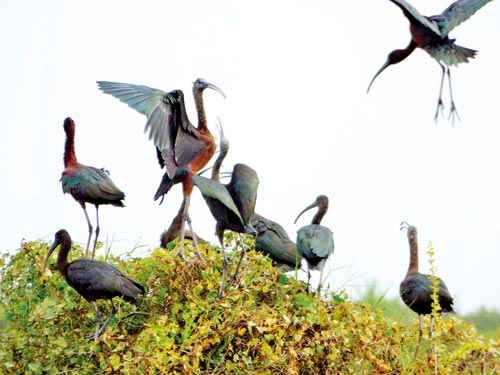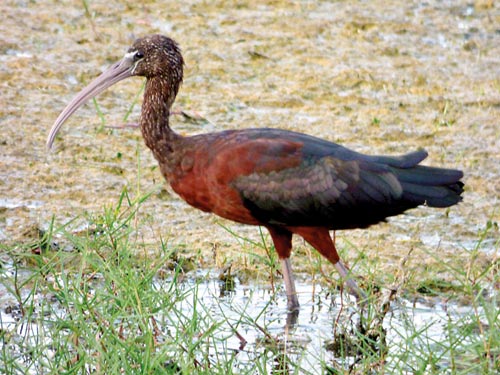Glossy Ibis: Jewel of Jaffna

Glossy ibis in Mandaitivu Pix by David Jeevathithan Ambalavanar
Sri Lanka is known for its beautiful diversity of bird life- at least 468 species of birds 34 endemic species and at least 226 migrant species. Within Sri Lanka, Jaffna and the Northern Province are also home to an array of birds, from storks, egrets and herons to kingfishers, kites and eagles and even ducks and grebes. However, while many birds are well documented and widely appreciated such as the migrating Greater flamingos, there is one bird species that does not receive anywhere near the attention it deserves: the Glossy ibis (Plegadis falcinellus).
Ibis are characterised by a small head, a long, curved beak, a long, gracefully curved neck and a rotund body with short tail feathers. They are frequently found in wetland habitats and feed mainly on insects, crustaceans, fish and small animals.
There are three species of ibis in
Sri Lanka. The most common and widespread species is the Black headed ibis (Threskiornis melanocephalus) seen across most of Sri Lanka and easily identified by its jet black head and neck, and white body. The Red-naped ibis (Pseudibis papillosa) commonly found in the Indian subcontinent was recorded in Sri Lanka in 2021, and is characterised by a brownish grey body, blue wings and a crimson head. However, the Glossy ibis is perhaps the most beautiful and most significant of all three species. Along with the Red-naped ibis, it is even referenced in Tamil Sangam literature as anril and used as an analogy for true devotion and love.

Glossy ibis in Kallundai
Glossy ibis are fairly small, only around two thirds the size of the Black headed ibis but perhaps the most obvious difference is its colour – a dazzling rainbow of colour. Immature individuals are a purplish maroon with purple green wings. Adult Glossy ibis are truly breath-taking, with a vibrant purplish red colouration, shimmering green wings, and feathers that shine with a multitude of colours depending on the angle of light; a phenomenon known as iridescence.
Glossy ibis also differ greatly from Black headed ibis and Red-naped ibis in their distribution.
Black headed ibis are naturally found across much of Asia and are a resident species across Sri Lanka, while Red-naped ibis are common across the Indian subcontinent. Glossy ibis found across Europe, Africa, Australia and even the Caribbean are the most widespread ibis species in the world, undertaking long migrations across entire continents. For instance, European populations of Glossy ibis will migrate to Africa for the winter and return for the summer. It is via these migrations that Glossy ibis arrive in Asia, though there are some resident populations in Western India.
Glossy ibis were initially present in abundance throughout Sri Lanka during the 1800s. However, within the next 50 years, populations decreased rapidly. It was only in 1952 that Glossy ibis began returning, with numbers increasing in the 1990s. In 1995, 81 Glossy ibis were recorded in the Muthurajawela wetland, the largest number recorded since their disappearance. In 2020, Glossy ibis populations were observed breeding in
Sri Lanka, for the first time in 148 years.
However, what has not received attention is their abundance. Most reports of Glossy ibis populations in Sri Lanka, even following the discovery of breeding populations, describe Glossy ibis as a scarce migrant, with only very scattered populations in places such as Yala and Bundala National Parks. However, in Jaffna and the Northern Province they seem to be positively thriving, though these observations have not been widely reported.
In February 2023, I was fortunate enough to observe a flock of at least 150 Glossy ibis in agricultural fields on the way to Poonakary. Throughout November and December of 2023, I also observed increasingly large flocks of Glossy ibis throughout Jaffna, from small flocks of a dozen birds to flocks of nearly 50 individuals, mostly in the wetlands near Kayts, Kallundai, Chemmani and Mandaitivu, with smaller populations in Sarasalai. In January 2024, I was fortunate enough to witness another large gathering of Glossy ibis in Kallundai, with at least 150 birds in a single flock, proof that these migratory populations are thriving in the Northern Province, despite the species still being considered a scarce migrant.
Despite the growing numbers of Glossy ibis in the Northern Province, their habitats are far from clean, with most wetlands and fields being polluted with rubbish and plastic. If our natural environments are not maintained, it won’t be long before even these huge flocks leave Sri Lanka for good. Their departure would be a very great loss as Glossy ibis truly are the underrated jewels of Jaffna and showcase just how varied the country’s biodiversity is.
Searching for an ideal partner? Find your soul mate on Hitad.lk, Sri Lanka's favourite marriage proposals page. With Hitad.lk matrimonial advertisements you have access to thousands of ads from potential suitors who are looking for someone just like you.


